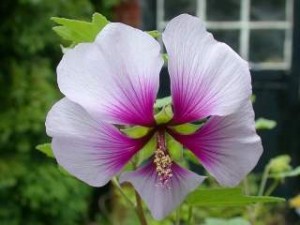Lavatera maritima
 Question from Charlie:
Question from Charlie:
It’s me again – the Lakeside woman that got married in Alice Menard’s garden. I was pruning my lavatera maritima last weekend and noticed a lot of large dead wood on it, as well as it appears to be more spindly than years ago. It is approximately 10-12 years old. How long do they normally live? Is there anything I can do to rejuvenate it? It is the only one in our yard and is a major focal point near a pond (man-made).
Answer from Pat:
Lavatera maritima can grow for a good eight or ten years if not overwatered where drainage is poor. It needs good drainage, fertile soil, and cutting back hard to keep it in bounds and encourage branching. When it is not adequately pruned, parts my become woody and then die back. By pruning often you keep it putting out fresh growth which then will bloom. Follow up with balanced fertilizer and water.
Lavatera maritima is not a permanent plant, however. I have seen many lovely specimens only after a few years to miss seeing them. Lavatera’s are mallows (Malvacceae). They are related to hollyhocks and no members of this family live long. It sounds to me as if your plant has reached the end of its life and if it lived ten or twelve years that’s amazing. If it dies, dig up the roots, amend and fertilize the soil, and plant a new one. It might be good to find another spot close to your pond but perhaps would be okay to plant the new one in the same place. They grow fast, so don’t cry over the old one, just get another. People often fail to do that because when their lavatera shrub dies they think they did something wrong and this discourages them from planting another. Not so. And in your case, you did amazingly. 10 or 12 years is a long life for this plant.


OK – how difficult do you think this will be to dig out, as the trunk on it is a good 5 inches in diameter. Are the roots huge too?
No, it should not be difficult. Cut off the branches with a long-handled lopper, saw off the trunk, leaving a long enough piece to shove back and forth, then dig up the roots section by section. If too tough for you, hire a man to do the job. He will finish very quickly so better have some other jobs too!
Thank you so much. My husband helps in that dept. It isn’t totally dead yet, so I plan to see what it looks like next spring.
Have a great day!
All Lavateras produce a lot of dead leaves which collect around the base, and can cause diseases such as die back. It’s a good idea to clear all this debris away, as well as pruning them by two feet I also give them a mulch of good compost, spray with a fungicide and apply some granular fertiliser.
Thanks for these helpful tips.